IPF webinar on "Bharatiya Economic Model"
Total Views |
IPF webinar on
"Bharatiya Economic Model"
14 April, 2022
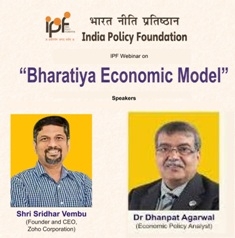
Speakers:
Shri Sridhar Vembu
(Founder and CEO, Zoho Corporation)
Dr Dhanpat Ram Agarwal
(National Co-convenor, Swadeshi Jagaran Manch)
Moderator:
Dr Kuldeep Ratnoo
(Director, India Policy Foundation)
Dr Kuldeep Ratnoo:
On behalf of India Policy Foundation, I welcome you all in the webinar on ‘Bharatiya Economic Model’. We are very happy to have Shri Sridhar Vembu and Shri Dhanpat Agarwal with us. We also have prominent people from different fields attending this webinar. Before we begin, I will introduce Sridhar Vembu ji, though he needs no introduction as all of us are familiar with him. He is a well-known personality, active on social media and a lot is being written about him. Not only because he is among the top 50 billionaires of India but also because of the amount of goodwill and respect he has gained all over the world.
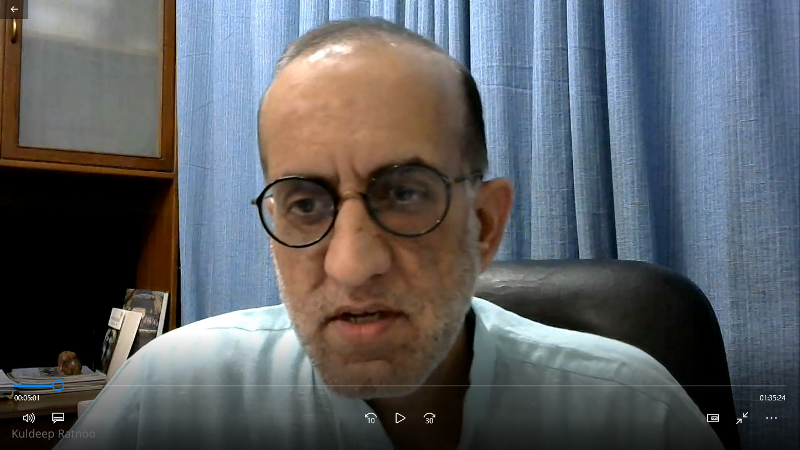
Sridhar Vembu ji is the founder and CEO of Zoho Corporation. He was born in 1968 in a family of landowners in a district in Tanjavur in Tamil Nadu. He studied in a Tamil medium school and after school, he graduated with a Bachelor’s degree in Electrical Engineering from IIT Madras in 1989 and thereafter he earned his MS and Doctorate from Princeton University in New Jersey, USA. In 1996, Vembuji along with his brothers and friends founded a software development company for network equipment providers called Advent Net. This company was renamed as Zoho Corporation in 2009 focussing on providing Software as a Service (SaaS), customer relationship management (CRM) services. At present, Zoho has more than six crore users worldwide and its profitin the last financial year was nearly Rs 2000 crore.
Sridhar Vembuji is renowned for taking software and product development functions from urban centres into villages of India, particularly in Tamil Nadu where his office is located. He also spends most of his time there. Zoho has its offices in Mathalamparai, Tenkasi district, Tamil Nadu and in suburban Renigunta, Andra Pradesh. Earlier, he worked in USA for some years and thereafter, he shifted his base to Tenkasi. However, Zoho has offices in all parts of the world. Revenue is also global, a fraction of that comes from India. His emphasison training youth, particularly from villages and making them software engineers, designers, coders etc., is particularly appreciated. In 2004, he set up Zoho schools to provide vocational software development education to rural students as an alternative to formal university education. A statement from the company states that more than 15 per cent of its engineers have no college degree. That is a big achievement. He has trained students from villages, which also includes students who are only school pass outs, and made them skilful and productive engineers. These students received education from Zoho schools. In 2020, he announced a rural school start up focussed on free primary education.
Sridhar Vembuji was awarded with Padma Shri in 2021. The same year, he was appointed to the National Security Advisory Board. On behalf of India Policy Foundation, I welcome you sir for giving us your precious time. We understand the kind of pressures and demands on your time. We are indeed grateful that you agreed to give your precious time to us, to speak on Bharatiya Economic Model.
Our next speaker today is Dr Dhanpat Ram Agarwal. He is national co-convenor of Swadeshi Jagaran Manch. We have worked together for SJM. I was Swadeshi Patrika editor in 2002. Since then, we have known each other and worked together. He is an expert on IPR and patent laws. He has been active in the field of accountancy and tax laws for more than 35 years. He did his graduation in Commercefrom St.Xavier’s College,and then studied Law at Calcutta University. Thereafter, he did his Ph.D. from North Bengal University. For Swadeshi movement, he has provided valuable insights concerning WTO and IPR. He regularly participates in national and international seminars on WTO and related topics. He has written innumerable articles on these issues and presented papers on various forums, national and international. He has also written and spoken on GM issues, Brexit, GST etc. He has been regularly organising international conferences on intellectual property rights known as Global Intellectual Property Convention for the past 10 years. His major thrust area of research is exchange rate and IPR, two pillars which he believes can move India ahead as a strong nation in the world. His focus is also on Bharatiya Economic Model.
We are very lucky to have two domain experts who have made a mark in their respective fields. I request Sridharji to start the discussion. The topic today is Bharatiya Economic Model and why is it important now, considering the situation that we are seeing all over the world, and what we have experienced so far. Why is it important to have a relook at the Bharatiya economic model which is considered very successful and very productive model? It is a job-centric model and it is a sustainable economic model. Over to you Sridhar ji.
Shri Sridhar Vembu
Namaskar to everyone!
I want to provide a background on the Bharatiya Economic Model. To me, it has to be primarily strengthening our grassroots, strengthening our rural areas. Our dharmic civilisation cannot survive purely as an urban civilisation. We have to have the strong base of our rural areas and we have to make them economically and socially stronger. So, that is my starting premise.
If you go back 100-200 years in history, an Indian village had a very self-reliant local and regional economy. What I mean by that is that our ecosystem was not only of farmers. It is mistake to think that village means only farming and agriculture, we have weavers, potters, carpenters, masons, ironsmiths, goldsmiths, rural vaidyas and many more from all other professions.All these were present in the villagesorin a cluster of villages. If you look today in 2022, the people who are third generation, fourth generation descendants of those rural craftsmen are either landless labourers or urban migrants because they were not farming focussed, they were in various trades and crafts. The surplus rural labour is due to the loss of livelihoods and the destruction of the traditional rural based industries. That is a very important point to understand. In other words, revival of rural areas is not merely revival of agriculture, it is also revival of rural-based production networks for various categories of goods and services.
Today, if you look at the assumption of conventional economic theory, what is being taught in our own universities and colleges is that villages will continue to decline and urbanisation is vital for prosperity. The leading economists have been saying that we have to urbanise and that villages will decline. I would call this the western derived economic model. We have to present a very strong alternative for this in the form of a Bharatiya Economic Model. I am going to call it the Dharmic Economic Model. How does this fit in with technology and other trends today? In my own belief and based on what we have seen in our company is that technological trends can reverse this rural decline. It can not only arrest it but can reverse rural decline. It can make rural areas stronger. We can strengthen our foundation as a nation and as a civilisation using technology trends. Correctly leveraging the technology trends, I believe it is possible. To this end, survival and prosperity of our rural areas depend on spreading technological know-how and capability. I will go into some details on this.
If you take our rural areas today, every young person has a motorcycle, smartphone and most of the houses have refrigerators. But how are they acquired? If you look at that, mostly it has an EMI payment, sometimes even multiple monthly payments. Even many of the agricultural workers have monthly payments. So, the demand for all of these goods is mostly enabled by debt and it is the debt which causes the rural economic distress. Our own wants and needs without the matching capability to produce is creating the debt and therefore creating the distress. This is the most fundamental problem. This comes from the idea that if you don’t have balance between production and consumption, if you consume without having the capability to produce, it leads to debt and eventually distress. Sri Lanka is a classic example of where the debt-oriented distress has taken them.
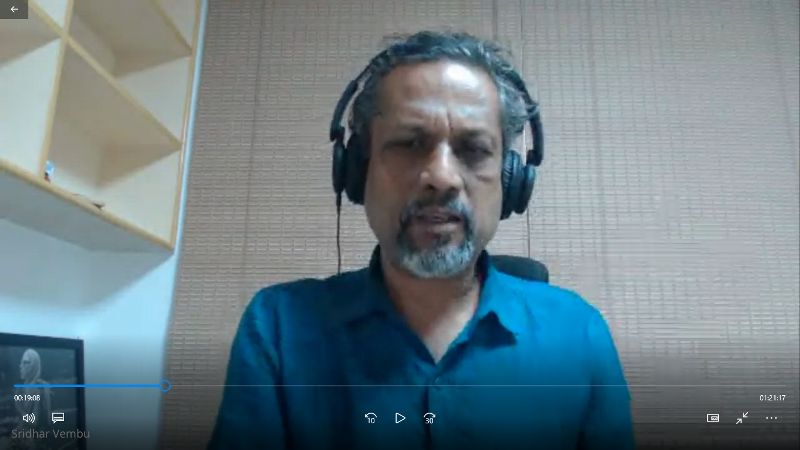
Rural prosperity is about primarily balancing production of manufactured goods with local consumption. We have to enable more rural-based production. It is not just production but rural-based production. Otherwise, again we are leading to the path of urbanisation. This urbanisation has two major issues for me. The first is the extremely high land prices. So, the cost of living in an urban area is often ten times that of a rural area. To give an example, in my village and the nearby region, you can get a house for rent for as low as Rs 1000 or even less. But in a city, it will be at least Rs 15,000. There is a ten times difference in that. So, it is important to not only produce but enable production in rural areas so that we retain our population in rural areas. The urbanisation is also leading to environmental distress, infrastructure stress and all of those problems. The one reason I moved myself to a village is to help restore that balance and to be able to create those productive jobs in rural areas.
How do we enable rural productivity? I am going to reduce it to one simple idea here – low-cost capital goods strategy. So, I will explainthis. I will come to the example of IT inventory where the crucial capital goodsare the personal computers, smartphones and network. Today, the personal computer is readily available, the smart phone is everywhere and the network is very readily and cheaply available. These ingredients are what enabled the IT revolution to reach the rural areas. Without this, a company like Zoho could not operate in a village like Mathalamparai in Tenkasi. India’s IT revolution happened because the capital good, the personal computer, got cheaper and became widely available. Millions of our programmers could have access to the necessary capital goods and create software codes. That is what enabled our IT revolution. In contrast, if the personal computers or smartphones were not invented, we could not have created the rural development sector like we have in Tenkasi. So, the capital goods coming down in price is very critical for rural software development to be viable. In fact, all of India’s software development itself owes a lot to the personal computer revolution. The same personal computer revolution enabled us to create rural jobs. Applying that same exact strategy, the broader capital goods revolution in mechanical, electronics is coming. I believe our nation Bharat can lead that wave of capital goods revolution.
The crucial technology trend is mechatronics where mechanical, electrical, electronics and software are blended. We essentially miniaturise and massively cost reduce capital goods. The capital goods that are enablers of production and productivity can be lowered in price and made available to many more people. The example of that kind of trend is, you take an electric car or electric auto rickshaw, the electric vehicles are a lot simpler in terms of mechanical parts than its corresponding internal combustion engine. In fact, the number of parts in an electric car is 20-30 times lower than in a regular car. It is a lot less complicated device. So, it is possible for an electric autorickshaw to be assembled in a rural factory. While a corresponding internal combustion counterpart will be much more complex and it may not be possible to assemble. In this case, this revolution that happened with electric vehicles can actually enable a different distribution of industry itself rather than few massive factories situated in a big urban centre. Smaller factories can actually become competent because of the reduced complexity. The complexity has also moved to software.
In these mechatronic devices, the power is conveyed electrically and controlled electronically. The mechanical system is replaced with electrical and electronic system and there is a software brain controlling all that through all those cables. This particular technology is not just technology, this could cause a revolution in the way that we manufacture. It could cause not only a technological revolution but corresponding rural economic transformation. The increasing value of an electric vehicle is in the software. This is important to note because our nation is very good at software and we have a lot of rural talent that we ourselves have developed that can produce that kind of software. This software that controls the brains of these electric vehicles is something that our rural engineers can produce. What is true for the electric vehicles also applies to many different kinds of factory equipment, whether it is the textile machinery or any other kind of production machinery, all of them can exploit the technology trend. This is the critical part. Our rural craftsmen or rural entrepreneurs can be enabled to be a proactive participant in the economy, supplying the local goods. So, smaller scale decentralised production becomes economically viable. This is a very critical observation.
I will highlight two major implications of this. Rural prosperity can be achieved by enabling our rural population to be producers rather than only be consumers of manufactured goods, particularly household goods like refrigerators, ceiling fans, iron boxes etc. All of these household items are spreading in rural areas expect that they are not producers but consumers of these. We have to change those dynamics. People have to be enabled to be producers, job creators and also be employed productively. We have to match production with consumption. This also helps the agricultural sector because agricultural productivity can also go up by lower cost capital goods for farmers. In the farm sector, we need all kinds of machines. That can be done in smaller scale machines, low-cost machines that can help the farmers. The same technology is foundation of defence too. If you look at drones and all of that, these are all mechatronics. I won’t go into the strategic defence implications.
Ultimately, this is all coming from the source of knowledge, the knowledge of how to produce these things or the capital goods revolution. And then, how to use them is the skills we talk about. Using the machinery skills, producing the machinery, is knowledge. Today, we need to gain the knowledge and the skills in our nation because major powers assert their control of this knowledge. Our sovereignty and security of the nation depends on gaining this knowledge. It is not only important for rural prosperity or rural revival, but this technology is very vital for sovereignty and security because of its implications for defence and other sectors.
How can we accelerate this capital goods revolution in India? I give the UPI as an example of a success story. By now, everybody sees how much of a revolution in payments India has achieved. India has leapfrogged western countries, particularly America in payments. How is that possible? Due to extraordinary low cost and it being extensively available. Even in small towns, UPI payments are accepted. And what enabled this is adoption of standards in identity, Aadhar, and mandating the adoption of this across banks. In effect, the standards are like our broad-gauge standards for trains. The government adopted it, mandated it and now it would be possible for our private sector to make passenger cars and engines. And now our new Open Network for Digital Commerce, those standards are trying to open up the e-commerce ecosystem so that we avoid a monopoly in e-commerce like it has happened in America and other places. Indiacan have much more open network by creating standardsso that every participant has a level playing field. For example, today the Google Meet has no standards and it cannot connect with Zoho or Zoom.
By mandating standards, we can enable intra-operability across all these providers. Those kinds of standards are necessary for capital goods revolution. So, for particularly those companies that produce household goods, we have to come up with standards and mandate those standards. The private sector can compete. For example, e-mail which is a standard that is open to all. Europe is now standardising instant messaging. So, WhatsApp, Telegram or other providers have to incorporate that. Similar effort is important for opening up markets. This is important for bringing down the cost of machine tools so that the various tools intra-operate and there are standards.
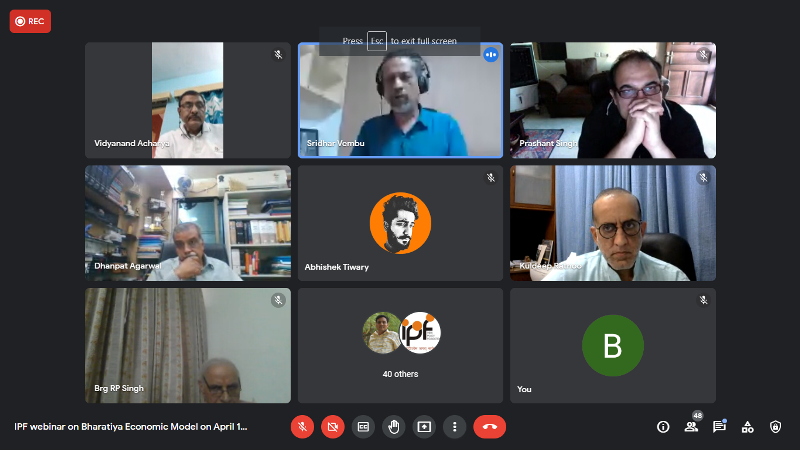
So, these are the actions I recommend – industrial R&D policy, economic policy and procurement policy. I will briefly address them. We have to holistically go through all of them. A strong R&D in capital goods for consumer goods, meaning you want capital goods that can help make household goods, helping miniaturise them for broad affordability. For all these, the talent exists in our research institutions like IITs etc. I visited IIT Madras. There is an advanced manufacturing research centre. We have really outstanding engineers guided by outstanding professors. All of these has to become our policy thrust in standardising this. Specifications, protocols, open standards for the machines are needed to enable low-cost production. And then we look at the manufacturing –casting and moulding, cutting, bending, shaping, grinding, polishing – all of these are work our rural craftsmen can do and the automation tools that enable the work to be producible in a rural area, for this all this have to become affordable so that people can become producers themselves. And small-scale industry takes off in rural areas. It can compete based on productivity with giants. The open source and open standards principles have to be applied to capital goods. I mentioned research labs. They have to create those designs and government has to adopt, mandate and promote. This is what happened in the case of UPI. It was created by a non-profit think-tank and then it was broadly adopted, the government mandated it and now it is an outstanding success. India has the largest payment system in the world by far at an extremely low cost.
The designs for capital goods should be open source. Private sector will been couraged and incentivised to make them. It is very critical. The designs should be widely available so that anybody can make them and anybody can participate in those markets and enable them. It is just like the PC market. PC is a very open design. A lot of vendors supply PCs in a similar way. It is the same thing with android phones. It is there in the open market and there are lot of vendors because of which it became more and more affordable. This revolution is needed in capital goods. Lowering the cost of capital goods, making them widely available,by standardising them, can allow us to leapfrog over the West just like it happened in payments. This is what I believe. In fact, I am personally investing in creating these specifications right now. But I think with a lot more effort, we can actually leapfrog as a nation.
There should also be policy support. Industrial policy in particular, especially tariffs. We have to make sure that in household consumer goods, we do not encourage any imports. We need to take a very strong stance against importing of household consumer goods. We should not be importing nail clippers, ceiling fans, iron boxes, refrigerators, their components and all of those things. These should be mandated to produce domestically which will increase the demand for capital goods. Domestic sourced capital goods investment should get preferential tax treatment. What I mean is, if you bought domestic capital goods to set up your unit, it can get depreciation.These kinds of tax policies can encourage buying more domestic goods. And for government procurement rules, they should mandate local production. This is the theme for technology-enabled decentralised rural development. This dream is achievable because I believe, first rural infrastructure and rural connectivity is getting better. Fibre optic connection is now more and more available and our government has introduced policy to enable fibre optic connectivity to all our villages which is an excellent policy and is very important. Digital connectivity is more important than rural connectivity.
Now I will look at the other positive factors other than capital goods - low cost of real estate, low cost of living. 10 lakhs per acre vs 10 crore per acre in cities or even more. Our labour costs are lower. Ultimately, a Rs 15,000 or Rs 20,000 job in a village actually enables a higher quality of life than even Rs 40,000 or Rs 50,000 jobs in an urban centre. Low cost of marketing and low cost of logistics are other factors. So, if we can get the capital goods revolution going, all of these other factors, together can make this dream possible. We can spark an industrial revolution in rural areas. I fervently believe this and I am working towards realising this vision. This revolution is uniquely Indian because that whole mix is not being put together by any other country. We will be uniquely Indian in our approach. These are the ingredients – capital goods, land, labour, logistics and marketing. These savings together can negate the scale required for very large-scale manufacturing. If we look at the numbers, it is not actually true that very large manufacturing is always more productive because all these things add up. We can be very cost-competitive. This is my final point. We cannot allow our rural areas to decline because our culture, our dharma all of that which are truly the soul of our nation are in rural India and we have to preserve it. This is the strategy I recommend for revival of rural areas and revitalise our civilisation. Thank you very much for listening.
Dr Kuldeep Ratnoo:
Thank you very much Sridhar ji. It was really enlightening to listen to your insights and your very valuable suggestions for India’s development, particularly through development of rural areas and these becoming production centres instead of remaining consumers. So, basically to shiftthe wind which has been going increasingly towards urbanisation and creating a lot more problems in the urban centres also. I am sure with your insights and dedication and devotion and also with a sensitive political leadership emphasising on Atmanirbharta (self-reliance), your ideas will go a long way in changing our economic conditions and overcoming the problem of unemployment due to increased urbanisation and also centralisation of production. It was great to have you here. Now I request Dhanpatji to give his presentation and his guidance on the Bharatiya Economic Model. Why is Bharatiyata so critical for our arthniti? Why is swadeshi a critical component of Bharatiyata and Atmanirbharata?
Dr Dhanpat Agarwal
Namaskar!
I thank Kuldeep Ratnooji and India Policy Foundation for organising this webinar.
I have been observing Sridhar Vembuji in his personal life too and we know that he acts upon his words. He has given employment to thousands of people in his village. He himself moves around on a cycle and works hard to realise the goal of a self-reliant India. I hope more such people come forward for the development of our country.
The topic for today is ‘Bharatiya Economic Model.’ Our rishis and maharishis have given guidance in the matter of economic development and they have mentioned certain virtues – Dharma, Arth, Kama and Moksha. Making dharma the foundation, they have mentioned abhyudaya nishreyas, which means we should develop both materially and spiritually. If we look at the thoughts and writings of Deen Dayal Upadhaya or Dattopant Thengadi, and when we see the global scenario, we realise that westernisation is not modernisation. For the last 30 years the wave of liberalisation, privatisation and globalisation has been going on in the country. But today, when you look at it, the biggest crisis before the youth of our country is unemployment. It is a topic where we need to understand and get our perspectives right. Our policy makers and thinkers need to engage in a serious debate.
What is the basic purpose of our economic policies? It is to better the lives and livelihoods of people. We need to see if poverty is getting alleviated, if people are able to find employment and whether they are getting oppressed under inflationary pressures. There is this trio of poverty, unemployment and inflation. In the last 30 years of economic development, it has been observed that along with growth, there is also rising inequality seen in the Indian society. At present, 10 per cent of the population controls more than 77 per cent of our wealth. Even now almost 25 per cent of the population falls below poverty line. If you take the rural and urban population, unemployment rate is still in double digits. Inflation has also been a major concern. The governments and the Reserve Bank have beentaking steps to address this issue.
At present our economy is distressed by the crisis brought about by Covid and the situation in Ukraine. This issue was discussed by the Swadeshi Jagaran Manch and the views of a number of experts were taken. We arrived at the conclusion that we need to formulate an economic policy which would make India self-reliant. Another such discussion was also conducted in Delhi in the month of February which was attended by stakeholders from across the political and economic spheres. From the deliberations, we realised that we need to bring about a change in mindset. And it is necessary for this change in mindset to be witnessed on two issues. The first is, consumers should naturally start choosing local goods, the desi goods. In May 2020, our prime minister had called for ‘vocal for local’ at the beginning of the Covid crisis. When we choose domestically made goods, our local employment will increase and our dependence on foreign goods will decrease. At present, we need to pay for these imports in foreign currencies which is a heavy burden on the nation’s economy. The challenge that arises when we compare locally made and foreign goods is that of quality. We need to ensure that the locally made goods are of good quality. The second issue is that of price. It needs to be competitive. In the era of globalisation, we cannot say that we will not import foreign goods as there are numerous rules in the WTO. If we look at domestically made goods from the perspective of quality and price competitiveness, it is important to invest in technology. That can increase the quality and competitiveness of swadeshi goods.
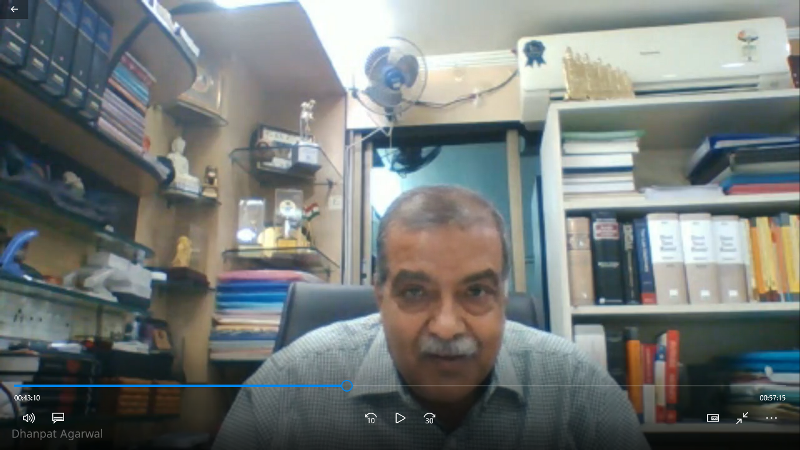
Along with bringing about the change in perspective with regard to domestically made goods, it is also important to bring about a change in mindset with regard to employment. We need to change the attitude of our graduate students who seek jobs. We have to teach them to be job providers. It is important to have a public awareness campaign and Swadeshi Jagaran Manch has already taken positive steps in this direction. We have also discussed abouthow to encourage entrepreneurship. With these steps, we can pose a strong challenge to foreign goods and contribute to the country’s development.
It is important to make India self-reliant. Now that we are celebrating 75 years of independence, it is necessary for us to take a note of where we stand. We need to see where we rank in the global economic order. The world’s GDP is around USD 90 trillion. US ranks number one with a GDP of USD 21 trillion, followed by China with an economy of USD 17-18 trillion, Japan with USD 5 trillion, Germany with USD 4.5 trillion and fifth is India with a GDP of USD 3 trillion. We are proud that we are the fifth largest economy in the world. But I would say that this cannot be the sole indication. We need to analyse if we can be happy with this or even with the goal of the USD 5 trillion economy that we have set for the nation. When we compare this with the ratio of our population, we can see that America has only five per cent of the world’s population and they have a share of 21-22 per cent in the world GDP. So, the ratio of GDP share with population share is nearly four times. China has around 19-20 per cent of the world population and they have a share of around 17-18 per cent in the world’s income. So, China has almost equal ratio. India has 17 per cent of the world’s population and only 3-3.5 per cent of the world’s income which is one-sixth in proportion. This is a huge challenge.
To address this, first we need to ensure that when we talk of economic development, we should have share of income that is proportionate to our population. We need to leapfrog to 17-18 per cent growth instead of the current five-six per cent. We need to bring about a paradigm shift in our policies. I will give you a bit of background of economic development in the country. 400 years ago, the livelihoods were based on natural resources. After Industrial Revolution, the use of capital resources increased and when it came to the 21st century, world economy is more technology driven and innovation driven and knowledge driven. When the economy was dependent on agriculture, natural resources were of prime importance. Now in a knowledge driven economy, the most important part is played by human resources. Economic resources are of three types –natural resource, capital resource and human resource. According to a study by World Bank, the weightage of human resource in the total resources of an economy is 64 per cent. Natural resources have a weightage of 20 per cent and capital resources have a weightage of 16 per cent. The weightage of human resources is four times more than the weightage of capital resources. But in the Indian economy, we have not been able to take advantage of human resources. When we talk of demographic dividend, we need to understand the gaps in our policy perspective because of which we are unable to use the power of our human resources.
Why is it that America is able to keep 21 per cent of world’s income? Out of the income of USD 21 trillion, USD 6.5 trillion comes from intellectual property rights like patents, brands and copyrights. This means that 34.68 per cent of their revenue comes from intellectual property which is more than double of what India’s GDP is. This is a huge gap and in order to close this gap, we will have to strengthen our research and development and our IP ecosystem. Our ideas like Vasudhaiva Kutumbakam and Sarve Bhavantu Sukhinah can be realised only if there is transformation of our human resources into intellectual resources. Only then we can make our products qualitative and price competitive. Till that time, our call for domestically made goods will be viewed as mere empty words.
We have encouraged and supported research in the field of information technology and pharmaceuticals. Today, we are competitive in these two areas. But if we look at other fields like automobiles, we can see that products are only assembled here and that there is no production. This is a big challenge. We have entrepreneurship in the field of textiles but to take this forward, we need to continuously encourage research and development. Few things are important in the IP ecosystem – creation of IP, protection of IP, enforcement of IP and commercialisation of IP. We are not commercialising the research that is being done in our universities. We need to spread more awareness for this to happen. In that too, it is important that the quality of research should be good to ensure commercialisation. If we strengthen our intellectual capital, then naturally, dependence on our imports will be less and the gap in our merchandise imports and exports can be brought down. There is a constant deficit in our trade and current accounts because of which we are forced to take a loan on our capital account. On one hand, we talk about self-reliance and we have foreign exchange reserves of over USD 550 billion. This foreign exchange reserve does not belong to us, it is essentially from foreign investment. We have more than USD 1 trillion in portfolio investments. Along with FDIs, if we look at the market value of these foreign investments, it is more than USD 1.5 trillion. We have to take a long-term view here. We need to take into account a number of other factors. We rank really low in human development index, global poverty index and also global innovation index. We need to understand these challenges and walk on the path shown by our rishis and maharshis.
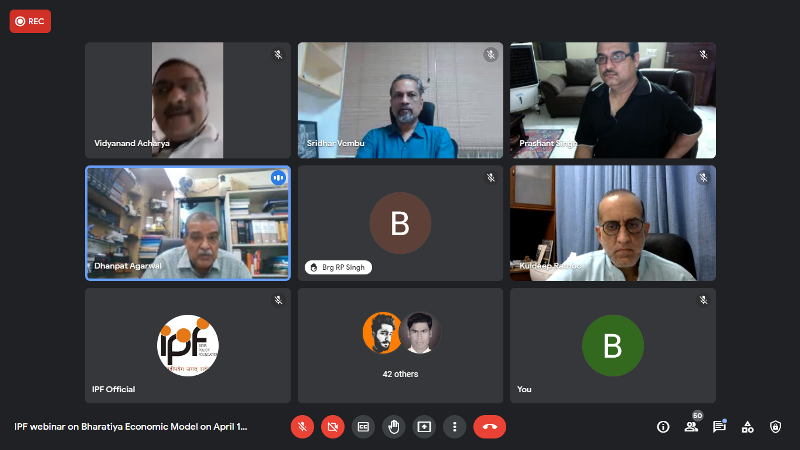
However, in the present age of globalisation which is knowledge driven, we will have to face more challenges with regard to unemployment due to artificial intelligence and disruptive innovation. China has understood this. Despite being called copy-cats, they have close to 13.5 lakh patents that are filed every year. In India, only 50,000 patents get filed. Today, China is the biggest filer of patents. In India, most of the patents that are filed are of MNCs. In the remaining, 80 per cent of the patents are filed by government institutions. We have to accept this fact and work towards increasing the contribution of Indian private sector.We need more entrepreneurs like Sridhar Vembuji in the private sector who understand this technology and uses it for rural development. We need to bring down our dependence on capital goods. This can become a reality only if there is local research. We may have the history of being one of the biggest economies of the world before Britishers came. But that glory cannot be reclaimed if we don’t accept our current drawbacks. We need to further our knowledge-intensive industries.
We can talk about labour intensive industries and carry forward our mission of “Vocal for Local.” We have recently observed in Bengal that almost 20-30 lakh people have found employment in the forest-based industries but their income levels are really low. Even if they are landowners, they are unable to get remunerative prices. In 1991, agriculture sector used to contribute 33 per cent to the Indian economy. Now that has come down to 17 per cent but the population dependence on the sector remains at 60 per cent. Services sector which contributes 60 per cent employs only 20-25 per cent of the population. So, we have to aim for equitable and sustainable development.
In my opinion, we should focus on six areas when it comes to economic development. First, development should be village centric. Second, the focus should be on employment. Third, the economically backward population should be our first priority. Fourth, it should be environmentally sustainable. Fifth, our development should be decentralised. And last but not the least, it should be based on our traditions, culture and dharma. If we take all these factors into account, I believe that we can go back to our Bharatiya Economic Model and ensure holistic development of the nation. I conclude my speech with these thoughts. Thank you.
Dr Kuldeep Ratnoo:
Thank you, Dhanpatji for giving a comprehensive picture of India’s economic development and for throwing light on important role our intellectual property could play. Thank you for discussing in depth the economic model India should follow. Now, I will take the liberty to ask the first question to Sridhar Vembuji.
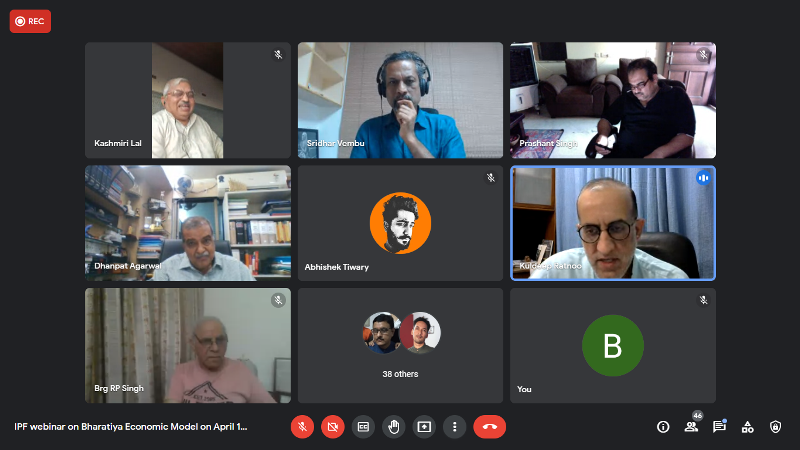
Q & A session
Dr Ratnoo: India has thousands of engineering colleges and lakhs of graduates have engineering degree. Still, they are considered as unemployable. You have to deal with large number of workforce that needs refined skills and where skills need to be updated frequently. There is a gap between the need of technology companies and what is being provided by our education system. Being an entrepreneur, what do you suggest to make these degree holders employable? How can we productively utilise them?
Shri Vembu: I look at the problem somewhat differently. Our primary job as entrepreneurs is to create and nurture the talent. It is a problem that we must solve instead of complaining about it. That is why we heavily invest in training and that is what enables us to be productive in rural areas. We don’t assume that there is talent already available. We put in the investment to make talent ready. This approach is also helpful in another way. It actually promotes more loyalty among employees because you invest in a person and they are naturally more attached to the organisation. I would suggest that entrepreneurs take that mindset that we will create and nurture the talent. There is lot of raw talent in our nation but it has to be shaped and moulded through training and skill development. And that is a job not just of colleges and universities. The reason why colleges and universities don’t do a good job is because colleges get better in an area only after the industry develops there. Take the case of countries like Japan and Germany. In California, training is done by people who are active programmers in the industry. So, the students get a lot of exposure. But if there is no industry in a rural area and if you don’t have exposure there, how will you get people who can train the students? That is why they don’t do a good job. I won’t blame them because they don’t have the experience base to train talent. Instructors themselves do not have experience. Industry will have to invest in new talent. Once we do that, then the next generation of colleges will have people from industry to teach.
So, it is very important for entrepreneurs to invest in training in our nation. The returns are enormous on skill development. To give you an idea, if you invest Rs 3-4 lakh in a person the annual productivity gain from that amount in training could be almost 20-30 lakh per year. In GDP terms, the return on skill development is enormous and that is why I would say that entrepreneurs and companies should invest in skill development. That is my solution. Once we do that, the colleges and industries in that area automatically get better.
Dr Ratnoo: You have developed a company without taking any external financial help and you have also passed two-three phases where many IT companies were in a troubling zone – the dot-com burst, the 2008 crisis etc. So, what would you suggest to technocrats and young entrepreneurs? How do they see the value of capital in terms of developing profit-makingcompanies in the long term?
Shri Vembu: I see capital in broader terms than only financial capital. The most important asset for the company is the human capital that we develop. As Agarwal ji mentioned, the value of all that in the brain is far more than the value of any physical assets in the bank. It is very important for entrepreneurs to build that skill capital, knowledge capital and cultural capital. That is equally important. And if we have a strategy particularly with the rural areas, you can reduce the consumption of financial capital because we simply need less money. Rent is cheap. Land is cheap. The difference between metros and rural areas could be hundred times. You can actually operate at much lower cost in a rural area. You can invest the savings in skill development and training of people. That will allow us to be competitive in the long term. That is what I recommend to investors. You should see how you can maximise your runway and how long you can operate.
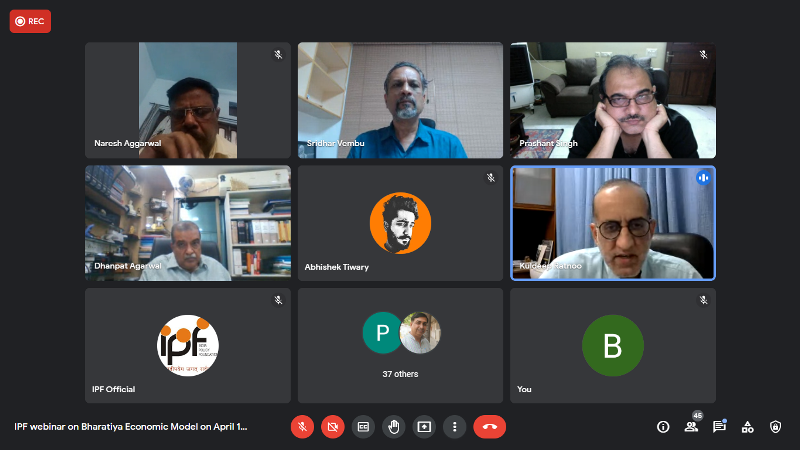
Vinod Johri: I would like to put forth a suggestion to create a website for Swavlambi Bharat Abhiyan where all the necessary links can be found and would guide those who are interested in the scheme.
Dr Agarwal: Swadeshi online has already created a website and you can post all your queries there.
Naresh Agarwal: What are the practical ways for entrepreneurs to get direct financial assistance from institutions?
Dr Agarwal: Under the Swavlambi Bharat Abhiyan, many organisations have come together, deliberated on this topic and put forth their suggestions. There are usually three problems that people face – finance, technology and marketing (FTM). We are organising awareness campaigns to make people understand that solutions are available. 12 organisations are already working in this area and we are trying hard to bridge the communication gap.
Prashant Singh: Why can’t we focus on the production of consumer goods in rural areas instead of focusing on the production of capital goods in rural areas?
Shri Vembu: My presentation is actually about enabling consumer goods. But to produce the consumer goods, we need lower cost capital goods. So, the capital goods will be designed anywhere and the rural areas will mostly produce consumer goods. To enable that, we need a lower cost capital goods strategy.
Dr Agarwal: There will be price competitiveness only if the costs of our capital goods are lowered and skilled labour are available.
Mohan Jain: I have a suggestion. We can produce all the raw materials in the villages which we consume in the cities. Another suggestion is to utilise the biomass in villages and come out with value added products. If all these units are set up in villages, it can give employment to millions of people in villages. For example, we should think of processing all the fruits and vegetables in villages itself. They should be processed and packed before sending it to cities. It will reduce costs and increase employment. A friend of mine, Hariharan has been working in this field for the last 25 years and he has opined that we can add an additional USD 2-3 trillion to the economy if we do this.
Q: How do you see religious economy in the future of India and what role can technology play in this since we consider India as a civilisational country? How do you visualise the synergy?
Dr Agarwal: Religious tourism can definitely strengthen our economy. We need to develop infrastructure surrounding religious areas like what prime minister Modi did for Kashi Vishwanath temple and also work towards making management of these areas efficient. Even otherwise, religious economy remains a huge source of employment for our country. Our religious centres can also provide relief to those who are going through stress and anxiety. Religion needs to be seen as a separate segment and the economy surrounding it needs to be studied further. The government should also create awareness and take steps towards strengthening religious economy.
Dr Ratnoo: Dhanpatji, the points that you have made are very valid. There is an economy surrounding every big temple in a city. Due to the inflow of pilgrims, thousands of new jobs are created every year in addition to the entrepreneurs who are there on a permanent basis. We need to give this a serious thought and think of ways to take this forward. There is a question about developing rural infrastructure which was already touched upon. As the infrastructure strengthens, there will be new opportunities.
Dr Agarwal: Rs 3 lakh crore has already been announced by our finance minister as part of the covid relief measure to strengthen marketing infrastructure and warehousing infrastructure in the rural areas. In the coming days through cooperative movements and institutions, there will be further value addition in this area.
Dr Ratnoo: I am very grateful to Sridhar Vembuji and Dhanpatji for addressing today’s webinar. I also thank all the participants who were patiently listening and raised pertinent questions. Many eminent persons are here. I thank all of you. I am sure it was enlightening for all to listen to our speakers today. Thank you very much!
***

